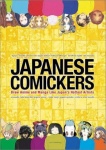
Pop culture retailers who deal in comic books have long known that the 'how to draw' books are perennial sellers to the hardcore fan audience that frequents comic shops. In the last few years How To Draw Manga volumes have sold as well or better than similar volumes based on the American comic book tradition, a trend that reflects manga's growing popularity and distinctive visual style. This May Harper Design International, an imprint of Harper/Collins is launching its own how to draw manga volume that was originally published in Japanese by one of Japan's leading magazines about manga, Comickers, a quarterly publication with a circulation in Japan of over 120,000. Harper's English version, Japanese Comickers: Draw Anime & Manga Like Japan's Hottest Artists, is more upscale (and more expensive) than most of its competitors in this increasingly crowded field. Japanese Comickers is a 128-page, 8 x 11' trade paperback that includes 350 color illustrations and retails for $24.95.
Not surprisingly considering the book's origin, the artists featured in the Harper guide are all Japanese (some 'how to draw' manga books are illustrated by western artists), but what is surprising is the fact that this volume eschews the traditional manga heavyweights in favor the latest wave of young creators ranging in age from 19-27. Some of the artists use digital tools while others work in more traditional media like watercolors and pencil. Each artist provides detailed instructions and explanations of their techniques. None of the works of the artists featured in this book, Yu Kagel, Hirofumi Fujiko, Naamirio, Noriko Meguro, Shunpei, Hinoki Anamori, Sunaho Tobe, nini, Hikaru Nakano, Ridoru, Ryugua, Yoko Tanji, Mey Suzuki, and Ippei Gyoubu, have been explored in any other English language publications. With its focus on young, cutting edge creators, Japanese Comickers is not an entry-level guide for inexperienced artists, rather it is more of a survey of a new generation of manga and anime creators that should appeal to fans and artists who are seriously interested in the latest trends in Japanese illustration.


